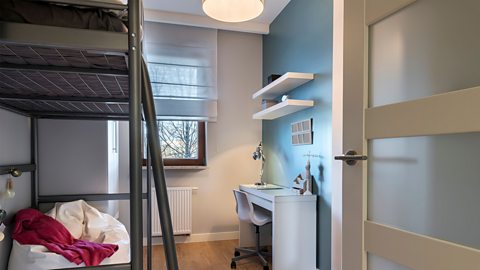Describing my room in Spanish.
Let me tell you about my room.
In my room there is‚ĶEn mi ≥Û≤π≤˙æ±≥Ÿ≤π≥¶æ±√≥≤‘ hay‚Ķ
A wardrobe - un armario.
A lamp - una l√°mpara.
And some posters - unos pósters.
My room is small.
Mi ≥Û≤π≤˙æ±≥Ÿ≤π≥¶æ±√≥≤‘ es ±Ë±±Á≥б√±≤π.
And because ≥Û≤π≤˙æ±≥Ÿ≤π≥¶æ±√≥≤‘ is feminine, it‚Äôs ±Ë±±Á≥б√±≤π, not ±Ë±±Á≥б√±¥«.
In terms of where things are…
Under is debajo de.
Under the bed there are lots of things - debajo de la cama ¬°hay muchas cosas!
On top of is encima de.
On top of the table there is a tablet - encima de la mesa hay una tableta.
Next to is al lado de.
Al lado de la cama…hay una silla roja - Next to the bed there is a red chair.
Remember silla is feminine so the colour has to be too, roja.
And that‚Äôs it, my room - mi ≥Û≤π≤˙æ±≥Ÿ≤π≥¶æ±√≥≤‘.
Describe what is in your room
To discuss what is in someone’s bedroom, you can ask:
- ¬øQu√© hay en tu ≥Û≤π≤˙æ±≥Ÿ≤π≥¶æ±√≥≤‘? - What is there in your bedroom?
You can answer by saying en mi ≥Û≤π≤˙æ±≥Ÿ≤π≥¶æ±√≥≤‘ hay‚Ķ (in my bedroom there is‚Ķ).
For example:
En mi ≥Û≤π≤˙æ±≥Ÿ≤π≥¶æ±√≥≤‘ hay una mesa, una cama y un armario - In my bedroom there is a table, a bed and a wardrobe.
En mi ≥Û≤π≤˙æ±≥Ÿ≤π≥¶æ±√≥≤‘ hay una l√°mpara y una ≥¶√≥≥楫ªÂ≤π para mi ropa - In my room there is a lamp and a chest of drawers for my clothes.
Remember, you don’t use the indefinite article (un/una) with no hay… (there is no…).
For example:
- En mi ≥Û≤π≤˙æ±≥Ÿ≤π≥¶æ±√≥≤‘ no hay televisi√≥n - In my bedroom there is no television.
Use the table below to say what there is and is not in your bedroom.
| Spanish | English |
|---|---|
| en mi ≥Û≤π≤˙æ±≥Ÿ≤π≥¶æ±√≥≤‘ hay‚Ķ | in my bedroom there is/are‚Ķ |
| en mi ≥Û≤π≤˙æ±≥Ÿ≤π≥¶æ±√≥≤‘ no hay‚Ķ | in my bedroom there is/are no‚Ķ |
| una cama | a bed |
| un armario | a wardrobe |
| una ≥¶√≥≥楫ªÂ≤π | a chest of drawers |
| un escritorio | a desk |
| una l√°mpara | a lamp |
| una televisión | a television |
| un ordenador | a computer |
| una alfombra | a rug |
| unas estanterías | (some) shelves |
| una litera | bunk beds |
| una puerta | a door |
| una silla | a chair |
| unos pósters | (some) posters |
Have a go at this activity to see how much you know about describing your room in Spanish!
Describing your room in more detail
If you want to add more detail or give extra information when you are talking about your room you can use different adjectives to describe it.

Adjectives are words which describe people, places or things.
A noun is a person, place or thing.
In Spanish, adjectives go after nouns and they must agree with the word they are describing.
Have a look at these examples:
Mi ≥Û≤π≤˙æ±≥Ÿ≤π≥¶æ±√≥≤‘ es peque√±_a_ pero c√≥mod_a_ - My bedroom is small but comfortable.
Mi madre piensa que mi ≥Û≤π≤˙æ±≥Ÿ≤π≥¶æ±√≥≤‘ es desordenad_a_ - My mum thinks that my bedroom is messy.
En mi ≥Û≤π≤˙æ±≥Ÿ≤π≥¶æ±√≥≤‘ hay una cama peque√±_a_ y una mesa desordenad_a_ - In my room there is a big bed and a messy table.
Some adjectives do not need to change as they are the same in both the masculine and feminine form, such as relajante.
For example:
- Tengo una cama grande y un armario verde - I have a big bed and a green wardrobe.

If you share your bedroom, you can use the verb compartir.
For example:
- Comparto mi ≥Û≤π≤˙æ±≥Ÿ≤π≥¶æ±√≥≤‘ con mi hermano - I share my room with my brother.

Use the adjectives in the table below to describe your bedroom or items in your bedroom. What different objects can you describe?
| English | Masculine | Feminine |
|---|---|---|
| small | ±Ë±±Á≥б√±¥« | ±Ë±±Á≥б√±≤π |
| big | grande | grande |
| tidy | ordenado | ordenada |
| messy | desordenado | desordenada |
| comfortable | ≥¶√≥≥楫ªÂ¥« | ≥¶√≥≥楫ªÂ≤π |
| relaxing | relajante | relajante |
| blue | azul | azul |
| red | rojo | roja |
| white | blanco | blanca |
| yellow | amarillo | amarilla |
| grey | gris | gris |
| blue | azul | azul |
Saying where things are in your room
To say where items are located use prepositions.
For example:
- La cama ±≤ı≥Ÿ√° al lado de la puerta - The bed is next to the door.

Prepositions are words and phrases like ‘under’ and ‘next to’. They tell you where something is.
Many prepositions need to be followed by de which will need to be contracted to del if followed by el.
For example:
La mesa ±≤ı≥Ÿ√° a la derecha del armario - The table is to the right of the wardrobe.
La l√°mpara ±≤ı≥Ÿ√° a la izquierda de la cama - The lamp is to the left of the bed.
Entre is one preposition that does not need to be followed by de.
For example:
- La mesa ±≤ı≥Ÿ√° entre las estanter√≠as y la puerta - The table is between the shelves and the door.
Remember that when talking about where something is located, you use the word ±≤ı≥Ÿ√° (is), from the verb 'estar' (to be) to describe where it is.
For example:
La cama ±≤ı≥Ÿ√° al lado de la puerta - The bed is next to the door.
La televisi√≥n ±≤ı≥Ÿ√° a la izquierda del armario - The television is to the left of the wardrobe.
Can you use the prepositions in the table to describe different objects in your bedroom?
| Spanish | English |
|---|---|
| al lado de | next to |
| encima de | on top of |
| debajo de | under |
| a la izquierda de | to the left of |
| a la derecha de | to the right of |
| delante de | in front of |
| detr√°s de | behind |
| enfrente de | opposite |
| entre | between |
Video
Watch the video then test your understanding of describing your room in Spanish in the short quiz!
√Å≥¢≥’¥°∏È∞ø: Hola Paula.
PAULA: Hola Álvaro. No encuentro mi cargador de móvil y tengo poca batería. Te lo presté hoy en el colegio.
√Å≥¢≥’¥°∏È∞ø: S√≠. Estoy en mi ≥Û≤π≤˙æ±≥Ÿ≤π≥¶æ±√≥≤‘ ahora. ¬øD√≥nde puede estar?
PAULA: ¬øEn el suelo?
√Å≥¢≥’¥°∏È∞ø: No lo veo.
PAULA: ¬øDebajo de la cama?
√Å≥¢≥’¥°∏È∞ø: No, no ±≤ı≥Ÿ√° debajo de la cama.
PAULA: ¬øAl lado de la l√°mpara?
√Å≥¢≥’¥°∏È∞ø: Tampoco.
PAULA: No lo sé… ¿Dentro del armario?
√Å≥¢≥’¥°∏È∞ø: Ay, ya, ay‚Ķ ¬°Comparto mi ≥Û≤π≤˙æ±≥Ÿ≤π≥¶æ±√≥≤‘ con mi hermano y √©l es muy desordenado!
PAULA: ¬°Espera! ¬°Creo que ±≤ı≥Ÿ√° al lado del ordenador!
√Å≥¢≥’¥°∏È∞ø: A ver‚Ķ
√Å≥¢≥’¥°∏È∞ø: ¬°Est√° aqu√≠!
PAULA: ¬°Genial! Paso por tu casa m√°s tarde para recogerlo. ¬øVale?
√Å≥¢≥’¥°∏È∞ø: ¬°Claro! Estar√© aqu√≠ hasta las cinco y media.
PAULA: Ok. Hasta luego. ¬°Gracias!
√Å≥¢≥’¥°∏È∞ø: De nada. Hasta luego.
Translation:
√Å≥¢≥’¥°∏È∞ø: Hi Paula
PAULA: Hi Alvaro. I can’t find my mobile charger and my battery is low. I lent it to you at school today.
√Å≥¢≥’¥°∏È∞ø: Yes, I‚Äôm in my room now. Where can it be?
PAULA: On the floor?
√Å≥¢≥’¥°∏È∞ø: I can‚Äôt see it.
PAULA: Under the bed?
√Å≥¢≥’¥°∏È∞ø: No, it‚Äôs not under the bed.
PAULA: Next to the lamp?
√Å≥¢≥’¥°∏È∞ø: Not there either.
PAULA: I don’t know… Inside the wardrobe?
√Å≥¢≥’¥°∏È∞ø: Argh‚Ķ.I share by bedroom with my brother and he‚Äôs really messy!
PAULA: Wait! I think it’s next to the computer!
√Å≥¢≥’¥°∏È∞ø: Let‚Äôs see‚Ķ
√Å≥¢≥’¥°∏È∞ø: It‚Äôs here!
PAULA: Great. I’ll come round to your house later to pick it up. OK?
√Å≥¢≥’¥°∏È∞ø: Of course! I‚Äôll be here until five thirty.
PAULA: OK. See you later. Thanks!
√Å≥¢≥’¥°∏È∞ø: No problem. See you later.
Quiz
Game - FestiLingo: Spanish. game
Visit the festival and practise Spanish language skills in this game

More on Topics
Find out more by working through a topic